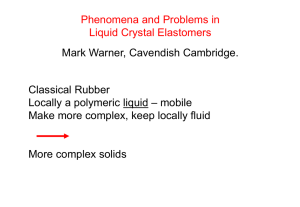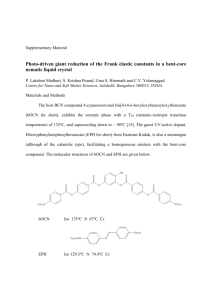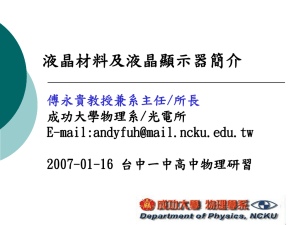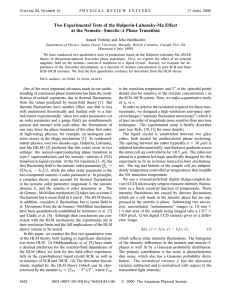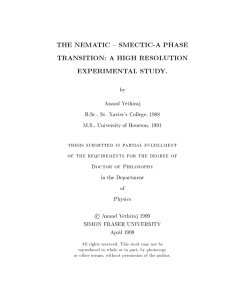¡ects at the High-resolution study of uctuation e nematic–smectic-A phase transition
advertisement
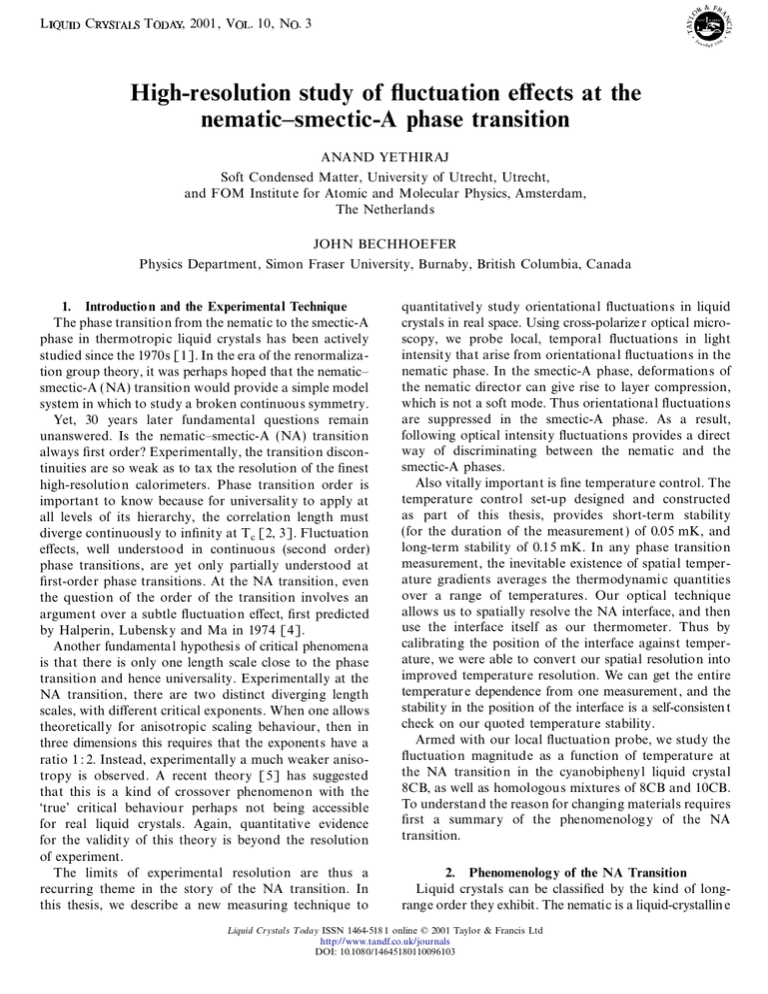
L C T , 2001, V . 10, N . 3 High-resolution study of uctuation e¡ects at the nematic–smectic-A phase transition ANAND YETHIRAJ Soft Condensed Matter, University of Utrecht, Utrecht, and FOM Institute for Atomic and Molecular Physics, Amsterdam, The Netherlands JOHN BECHHOEFER Physics Department, Simon Fraser University, Burnaby, British Columbia, Canada 1. Introduction and the Experimental Technique The phase transition from the nematic to the smectic-A phase in thermotropic liquid crystals has been actively studied since the 1970s [1]. In the era of the renormalization group theory, it was perhaps hoped that the nematic– smectic-A (NA) transition would provide a simple model system in which to study a broken continuous symmetry. Yet, 30 years later fundamental questions remain unanswered. Is the nematic–smectic-A (NA) transition always rst order? Experimentally, the transition discontinuities are so weak as to tax the resolution of the nest high-resolution calorimeters. Phase transition order is important to know because for universality to apply at all levels of its hierarchy, the correlation length must diverge continuously to in nity at T [2, 3]. Fluctuation c e¡ects, well understood in continuous (second order) phase transitions, are yet only partially understood at rst-order phase transitions. At the NA transition, even the question of the order of the transition involves an argument over a subtle uctuation e¡ect, rst predicted by Halperin, Lubensky and Ma in 1974 [4]. Another fundamental hypothesis of critical phenomena is that there is only one length scale close to the phase transition and hence universality. Experimentally at the NA transition, there are two distinct diverging length scales, with di¡erent critical exponents. When one allows theoretically for anisotropic scaling behaviour, then in three dimensions this requires that the exponents have a ratio 1 : 2. Instead, experimentally a much weaker anisotropy is observed. A recent theory [5] has suggested that this is a kind of crossover phenomenon with the ‘true’ critical behaviour perhaps not being accessible for real liquid crystals. Again, quantitative evidence for the validity of this theory is beyond the resolution of experiment. The limits of experimental resolution are thus a recurring theme in the story of the NA transition. In this thesis, we describe a new measuring technique to quantitatively study orientational uctuations in liquid crystals in real space. Using cross-polarize r optical microscopy, we probe local, temporal uctuations in light intensity that arise from orientational uctuations in the nematic phase. In the smectic-A phase, deformations of the nematic director can give rise to layer compression, which is not a soft mode. Thus orientational uctuations are suppressed in the smectic-A phase. As a result, following optical intensity uctuations provides a direct way of discriminating between the nematic and the smectic-A phases. Also vitally important is ne temperature control. The temperature control set-up designed and constructed as part of this thesis, provides short-term stability (for the duration of the measurement ) of 0.05 mK, and long-term stability of 0.15 mK. In any phase transition measurement, the inevitable existence of spatial temperature gradients averages the thermodynamic quantities over a range of temperatures. Our optical technique allows us to spatially resolve the NA interface, and then use the interface itself as our thermometer. Thus by calibrating the position of the interface against temperature, we were able to convert our spatial resolution into improved temperature resolution. We can get the entire temperatur e dependence from one measurement , and the stability in the position of the interface is a self-consisten t check on our quoted temperature stability. Armed with our local uctuation probe, we study the uctuation magnitude as a function of temperature at the NA transition in the cyanobiphenyl liquid crystal 8CB, as well as homologous mixtures of 8CB and 10CB. To understand the reason for changing materials requires rst a summary of the phenomenology of the NA transition. 2. Phenomenology of the NA Transition Liquid crystals can be classi ed by the kind of longrange order they exhibit. The nematic is a liquid-crystallin e L iquid Crystals T oday ISSN 1464-518 1 online © 2001 Taylor & Francis Ltd http://www.tandf.co.uk/journals DOI: 10.1080/14645180110096103 2 A. Yethiraj and J. Bechhoefer phase that often occurs in a material composed of rodlike molecules. Although the centre-of-mass of the molecules are disordered, the rods tend to align spontaneously: the nematic phase therefore has orientational order (denoted by a magnitude S and a ‘director’ n, a headless unit vector giving the local direction of orientational order), but no positional order. The smectic-A phase not only has orientational order like a nematic, it also exhibits a density modulation (‘layering’) in the direction of the director. It is characterized by a two-component order parameter that captures both the amplitude and the phase of the density modulation. When an isotropic liquid is cooled into the nematic phase, three-dimensional rotational symmetry is spontaneously broken, and the average direction picked out is usually governed by weaker surface anchoring e¡ects. This has two outcomes. First, one can easily make a single domain nematic (analogous to a single crystal in solid state physics) by controlling the surface treatment of the bounding surfaces. Second, uctuations of the director are a soft mode in the nematic. Because of this, the nematic has only partial orientational order. In the smectic-A phase orientational uctuations are suppressed. Thus smectic ordering is intrinsically coupled with an increase in the nematic ordering. This coupling, referred to as the deGennes-McMillan coupling provides a mechanism that can drive the transition rst-order when the NA transition is su ciently close to the isotropic-nematic (IN) transition. Thus an important parameter in the phenomenology of the NA transition is the nematic range, parametrized by the ratio T /T . NA IN In experiments, this e¡ect manifests itself as a linear dependence of the latent heat on mixture concentration in a homologous series of two very similar liquid crystals, with the latent going to zero at a point known as the Landau tricritical point (LTP). In addition to this coupling, there also exists a more subtle coupling between the smectic order parameter and the nematic director. The anisotropy of the liquid crystal system requires the gradient terms in a smectic free energy expansion to be anisotropic, with the gradient terms parallel and perpendicular to the director having di¡erent multiplicative pre-factors. Local uctuations in the director imply local variations in the gradient direction. Writing this free energy in a covariant form naturally incorporates this coupling. Once again, the strength of this coupling is expected to be large when director uctuation s are strong, i.e. when the nematic range is small. Calculating the e¡ect of director uctuations, while ignoring the e¡ect (possibly important ) of smectic uctuations, Halperin, Lubensky and Ma arrived at the prediction that the transition would always be at least weakly rst order. In the e¡ective smectic free energy derived by them, there was a negative cubic term that would not be allowed in a local free energy. Experimentally, this would imply a non-linear crossover from the linear behaviour of the latent heat as a function of mixture concentration. In the 8CB-10CB system which is close to the small-nematic-rang e limit, Anisimov et al. [6] showed that there was indeed a non-linear crossover near the Landau tricritical point (LTP) showing that the LTP was not a true tricritical point. However, the resolution of the adiabatic calorimetry experiments [7] ran out before reaching pure 8CB, where the transition was consistent with being second order. Here, a novel dynamical technique by Cladis and coworkers [8] showed by examining front propagation velocities that even in 8CB the transition was rst order. However, while being a good qualitative rst test of phase transition order, it did not provide an accurate quantitative estimate of discontinuity strength that could be used to test HLM theory. This experiment highlights the jump in sensitivity that is possible in measuring equilibrium quantities by driving the system slightly out of equilibrium, and provided us with a starting point for our quantitative studies. 3. Results In our studies, we employed two independent probes of a uctuation-induced rst-order phase transition in the 8CB-10CB system. First we have studied the NA transition in pure 8CB. The uctuations in the nematic obey a well-de ned power law in the nematic phase that extrapolates to zero at a temperature T* (which is like the spinodal point) with an exponent n 0.5 (see gure 1). However, before this extrapolated temperature, the uctuations are discontinuously interrupted by the advent of the smectic-A phase. This discontinuity is characterized by the normalized di¡erence between the transition temperature T and the extrapolated temperNA ature T*. Thus we nd the transition to be clearly rst order, with a dimensionless discontinuity t 1.6 10 5. 0 We then explored theoretically [9] the e¡ect of an external applied magnetic eld on the phase transition. The prediction from this theoretical analysis, which is essentially an extension of the HLM theory, was a linear suppression of the zero- eld discontinuity. Moreover, we predicted a eld-induced tricritical point at a modest value of the magnetic eld. In 8CB, this tricritical point was estimated to be about 10 T. This implied an easily measurable suppression of t for magnetic elds of 1.5 T, 0 accessible in our laboratory. We measured experimentally [10, 11 ] the e¡ect of a magnetic eld in pure 8CB, and two 8CB-10CB mixtures. In none of these samples do we observe a suppression of uctuations close to T . With our technique, we can NA High-resolution study of uctuation e ects Figure 1. Pure 8CB, d 30 l m, 0.59 0.02 K/cm. Here t ( 5.0 0.5 mK)/(307 K) 1.6 0.1 10 5. Results are 0 shown with and without an external applied magnetic eld. unambiguously measure a depression as small as 10%. This sets a lower bound on the critical eld, in all the experiments, of 30 T. We do, however, measure the expected non-critical magnetic eld e¡ect, the suppression of the uctuations in the nematic phase. The suppression of the variance goes as H2, as expected. The coe cient of this eld suppression, g , displays a temperature dependence that H is consistent with a critical divergence with a power law n 0.5. This, in turn, is internally consistent with our zero- eld results. Second, we explore the dependence of t on the 0 concentration of 10CB in 8CB-10CB mixtures. The discontinuity gets larger as we approach the Landau tricritical point. The ts to HLM were done using the Anisimov parameters and with C and the sixth-order 0 coe cient, E, as free parameters. Because the sixthorder coe cient is found robustly to be close to unity, this is essentially a one-parameter t. In particular, we nd that the data near the LTP (see gure 2) agree with the HLM prediction for reasonable values of the quartic coe cient C and agrees as well with the experimental 0 ndings of Anisimov et al. However, for lower concentrations of 10CB in 8CB, there is a clear deviation from the HLM prediction. This suggests that the HLM theory underestimates the latent heat in this region of the phase diagram. This is surprising, given the expectation that 3 Figure 2. (a) Fit of t data to the Anisimov parameters ([6]) 0 with C and E as t parameters. Top and bottom dashed 0 curves show ts for n 0.6 and n 0.4, respectively (n 0.5 is the tted exponent to the power law observed). (b) Comparison of latent heat data ( [7]) to t data 0 (this work). Open circles: data taken from [7]; lled circles: t data converted to equivalent latent heat. 0 the negative cubic term in the e¡ective smectic free energy, which is induced by director uctuations, should get smaller with increasing nematic range. 4. Conclusions These experimental results [10, 11] are robust and suggest an unambiguous deviation from both the deGennes-McMillan form and HLM theory. Our new experimental method is self-contained and is a precise measure of latent heat with an accuracy of 10% or better, in a range that is outside that of adiabatic calorimetry. We presented three main results, two experimental and one theoretical. The theoretical prediction extended the HLM mechanism to include the e¡ect of an external magnetic (or electric) eld. The prediction is noteworthy because the critical eld predicted is modest, and would imply small but easily measurable e¡ects in our experimental set up. Experimentally, we observe no such magnetic eld e¡ect, thus allowing us to place a lower bound on the critical eld. Experimentally too, we nd a dependence of the zero- eld discontinuity t that shows quantitative 0 deviation from HLM theory away from the LTP. These results point to the importance of taking into account smectic uctuations in a future theory. Recent work by Herbut et al. [12] indicates that a renormalization group calculations yields an increase in rst-order discontinuity relative to the HLM value High-resolution study of uctuation e ects 4 (which is mean eld in the smectic order parameter) close to the LTP, as originally observed in our experimental work. This is promising, as it is the rst quantitative comparison between experiment and theory in the region beyond the LTP where smectic uctuations begin to be important. Because the question of phase transition order has wide rami cations in the understanding of measured critical exponents, the search for the tricritical point at the NA transition remains interesting. Additional note. Recently, I. Lelidis [13] measured the e¡ect of an external electric eld along the nematic director and concluded that the NA transition in 8CB becomes second order at a eld of 13V/l m. This is roughly equivalent to an external eld of 130 T, which is consistent with our results. References [1] D G , P. G., and P , J., 1993, T he Physics of L iquid Crystals, second edition (Clarendon Press: Oxford). [2] P , P., and T , G., 1977, Introduction to the Renormalization Group and to Critical Phenomena (John Wiley & Sons: New York). [3] C , P. E., 1999, in D. Demus et al. (eds) Physical Properties of L iquid Crystals, ( Wiley-VCH: New York), pp. 277. [4] H , B. I., L , T. C., and M , S. K., 1974, Phys. Rev. L ett., 32, 292. [5] P , B. R., and A , B. S., 1992, Phys. Rev. L ett., 69, 1556. [6] A , M. A. et al., 1987, Phys. Rev. A, 41, 6749, and A , M. A. et al., 1987, JET P L ett., 45, 425. [7] M , H., T , J., and D , W., 1985, Mol. Cryst. L iq. Cryst., 124, 195. [8] C , P. E. et al., 1989, Phys. Rev. L ett., 62, 1764. [9] M , R., Y , A., and B , J., 1999, Phys. Rev. L ett., 83, 4796. [ 10 ] Y , A., and B , J., 2000, Phys. Rev. L ett., 84, 3642. [ 11 ] Y , A., 1999, unpublished PhD thesis, Simon Fraser University. [ 12 ] H , I., Y , A., and B J., 2001, Europhys. L ett., 55, 317. [ 13 ] L , I., 2001, Phys. Rev L ett., 86, 1267.
